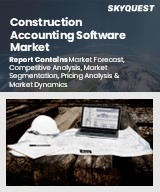
|
시장보고서
상품코드
1681676
회계 소프트웨어 시장 규모, 점유율, 성장 분석 : 배포 유형별, 컴포넌트별, 유형별, 최종 용도별, 지역별 - 산업 예측(2025-2032년)Accounting Software Market Size, Share, and Growth Analysis, By Deployment Type (On-premise, Cloud-based), By Component (Solution, Services), By Type, By End Use, By Region - Industry Forecast 2025-2032 |
||||||
회계 소프트웨어 시장 규모는 2023년에 169억 달러에 달하며, 예측 기간(2025-2032년)의 CAGR은 8.8%로, 2024년 183억 9,000만 달러에서 2032년에는 361억 달러로 성장할 전망입니다.
세계의 회계 소프트웨어 시장은 금융사기 발생률 증가와 규제 준수에 대한 관심 증가로 인해 큰 성장이 예상됩니다. 이러한 추세는 전 세계에서 회계 솔루션에 대한 수요를 증가시킬 것으로 예상됩니다. 또한 스타트업의 급격한 증가는 소프트웨어 프로바이더에게 유리한 기회를 제공합니다. 회계 소프트웨어를 제공하는 기업은 AI를 포함한 첨단 기술의 통합을 우선시하고, 수요가 높은 자동화 솔루션을 촉진해야 합니다. 그러나 데이터 마이그레이션의 복잡성, 프라이버시 문제, 보안 문제, 변화에 대한 저항 등의 문제는 시장 성장을 저해할 수 있습니다. 전반적으로 회계 소프트웨어에 대한 수요는 증가할 것으로 예상되지만, 이러한 진화하는 상황에서 지속적으로 성공하기 위해서는 이러한 장애물을 해결하는 것이 중요할 것으로 보입니다.
목차
서론
- 조사의 목적
- 조사 범위
- 정의
조사 방법
- 정보 조달
- 2차와 1차 데이터 방법
- 시장 규모 예측
- 시장의 전제조건과 제한
개요
- 세계 시장 전망
- 공급과 수요 동향 분석
- 부문별 기회 분석
시장 역학과 전망
- 시장 개요
- 시장 규모
- 시장 역학
- 촉진요인과 기회
- 억제요인과 과제
- Porter의 산업 분석
주요 시장 인사이트
- 주요 성공 요인
- 경쟁의 정도
- 주요 투자 기회
- 시장 에코시스템
- 시장의 매력 지수(2024년)
- PESTEL 분석
- 거시경제 지표
- 밸류체인 분석
- 가격 분석
회계 소프트웨어 시장 규모 : 배포 유형별
- 시장 개요
- 온프레미스
- 클라우드 기반
회계 소프트웨어 시장 규모 : 컴포넌트별
- 시장 개요
- 솔루션
- 서비스
회계 소프트웨어 시장 규모 : 유형별
- 시장 개요
- 스프레드시트
- 급여 관리 소프트웨어
- 청구 및 청구서 소프트웨어
- 상업 회계 소프트웨어
- 기업 회계 소프트웨어
- 커스텀 회계 소프트웨어
회계 소프트웨어 시장 규모 : 최종 용도별
- 시장 개요
- 소매
- BFSI
- 제조업
- IT 및 통신
- 정부 및 공공 부문
- 에너지·유틸리티
- 미디어와 엔터테인먼트
- 의약품·헬스케어
- 기타
회계 소프트웨어 시장 규모
- 북미
- 미국
- 캐나다
- 유럽
- 독일
- 스페인
- 프랑스
- 영국
- 이탈리아
- 기타 유럽 지역
- 아시아태평양
- 중국
- 인도
- 일본
- 한국
- 기타 아시아태평양
- 라틴아메리카
- 브라질
- 기타 라틴아메리카 지역
- 중동 및 아프리카
- GCC 국가
- 남아프리카공화국
- 기타 중동 및 아프리카
경쟁 정보
- 상위 5사의 비교
- 주요 기업의 시장 포지셔닝(2024년)
- 주요 시장 기업이 채택한 전략
- 최근 시장 동향
- 기업의 시장 점유율 분석(2024년)
- 주요 기업의 기업 개요
- 기업의 상세
- 제품 포트폴리오 분석
- 기업의 부문별 점유율 분석
- 매출의 전년대비 비교(2022-2024년)
주요 기업 개요
- Intuit Inc.(USA)
- Sage Group plc(UK)
- Xero Limited(New Zealand)
- Oracle Corporation(USA)
- SAP SE(Germany)
- Workday, Inc.(USA)
- Microsoft Corporation(USA)
- Zoho Corporation(India)
- FreshBooks(Canada)
- Bill.com(USA)
- BlackLine, Inc.(USA)
- Deltek(USA)
- Unit4(Netherlands)
- FinancialForce(USA)
- Acumatica(USA)
- Tally Solutions Pvt. Ltd.(India)
결론과 제안
KSA 25.04.29Accounting Software Market size was valued at USD 16.9 billion in 2023 and is poised to grow from USD 18.39 billion in 2024 to USD 36.1 billion by 2032, growing at a CAGR of 8.8% during the forecast period (2025-2032).
The global accounting software market is poised for significant growth, driven by the rising incidence of financial fraud and the increasing focus on regulatory compliance. This trend is anticipated to boost demand for accounting solutions worldwide. Additionally, the surge in startups presents lucrative opportunities for software providers. Companies offering accounting software should prioritize the integration of advanced technologies, including AI, to facilitate automated solutions that are becoming highly sought after. However, challenges such as data migration complexities, privacy concerns, security issues, and resistance to change may hinder market growth. Overall, while the demand for accounting software is expected to rise, addressing these hurdles will be critical for sustained success in this evolving landscape.
Top-down and bottom-up approaches were used to estimate and validate the size of the Accounting Software market and to estimate the size of various other dependent submarkets. The research methodology used to estimate the market size includes the following details: The key players in the market were identified through secondary research, and their market shares in the respective regions were determined through primary and secondary research. This entire procedure includes the study of the annual and financial reports of the top market players and extensive interviews for key insights from industry leaders such as CEOs, VPs, directors, and marketing executives. All percentage shares split, and breakdowns were determined using secondary sources and verified through Primary sources. All possible parameters that affect the markets covered in this research study have been accounted for, viewed in extensive detail, verified through primary research, and analyzed to get the final quantitative and qualitative data.
Accounting Software Market Segments Analysis
Global Accounting Software Market is segmented by Deployment Type, Component, Type, End Use and region. Based on Deployment Type, the market is segmented into On-premise and Cloud-based. Based on Component, the market is segmented into Solution and Services. Based on Type, the market is segmented into Spreadsheets, Payroll Management Software, Billing & Invoice Software, Commercial Accounting Software, Enterprise Accounting Software and Custom Accounting Software. Based on End Use, the market is segmented into Retail, BFSI, Manufacturing, IT &Telecom, Government & Public Sector, Energy & Utilities, Media & Entertainment, Pharmaceutical & Healthcare and Others. Based on region, the market is segmented into North America, Europe, Asia Pacific, Latin America and Middle East & Africa.
Driver of the Accounting Software Market
The burgeoning global start-up ecosystem is creating a surge in small and medium-sized enterprises (SMEs). As these new businesses emerge, the necessity for strict adherence to financial regulations and the maintenance of accurate accounting records becomes increasingly vital. This demand for compliance and efficient financial management is, therefore, propelling the growth of the accounting software market. As SMEs seek solutions to streamline their accounting processes and ensure regulatory compliance, the market for accounting software continues to expand in response to their needs. This trend highlights the essential role of accounting software in supporting the financial health of emerging companies.
Restraints in the Accounting Software Market
The transition from traditional accounting management systems to modern software poses significant challenges, primarily due to the potential incompatibility of legacy systems with newer technologies. This complexity in migration is anticipated to impede the widespread adoption of accounting software in the future. As organizations face difficulties in integrating their existing systems with advanced solutions, this resistance may slow down the overall growth of the accounting software market. The intricacies involved in such transitions often lead to hesitations that could deter businesses from embracing innovative tools that could enhance their financial management capabilities. Consequently, this serves as a notable restraint within the market.
Market Trends of the Accounting Software Market
The Accounting Software market is witnessing a significant trend towards customized solutions, driven by the increasing demand for personalized functionalities from diverse industries. As businesses and individuals seek software that caters specifically to their unique financial processes and reporting needs, companies are pivoting towards offering bespoke accounting software developments. This trend is poised to enhance user satisfaction, improve operational efficiencies, and ultimately expand business scopes over the long term. Additionally, advancements in technology, including artificial intelligence and cloud computing, are expected to drive further innovations in customization, making tailored accounting solutions an essential feature in the competitive landscape of the accounting software market.
Table of Contents
Introduction
- Objectives of the Study
- Scope of the Report
- Definitions
Research Methodology
- Information Procurement
- Secondary & Primary Data Methods
- Market Size Estimation
- Market Assumptions & Limitations
Executive Summary
- Global Market Outlook
- Supply & Demand Trend Analysis
- Segmental Opportunity Analysis
Market Dynamics & Outlook
- Market Overview
- Market Size
- Market Dynamics
- Drivers & Opportunities
- Restraints & Challenges
- Porters Analysis
- Competitive rivalry
- Threat of substitute
- Bargaining power of buyers
- Threat of new entrants
- Bargaining power of suppliers
Key Market Insights
- Key Success Factors
- Degree of Competition
- Top Investment Pockets
- Market Ecosystem
- Market Attractiveness Index, 2024
- PESTEL Analysis
- Macro-Economic Indicators
- Value Chain Analysis
- Pricing Analysis
Global Accounting Software Market Size by Deployment Type & CAGR (2025-2032)
- Market Overview
- On-premise
- Cloud-based
Global Accounting Software Market Size by Component & CAGR (2025-2032)
- Market Overview
- Solution
- Services
Global Accounting Software Market Size by Type & CAGR (2025-2032)
- Market Overview
- Spreadsheets
- Payroll Management Software
- Billing & Invoice Software
- Commercial Accounting Software
- Enterprise Accounting Software
- Custom Accounting Software
Global Accounting Software Market Size by End Use & CAGR (2025-2032)
- Market Overview
- Retail
- BFSI
- Manufacturing
- IT & Telecom
- Government & Public Sector
- Energy & Utilities
- Media & Entertainment
- Pharmaceutical & Healthcare
- Others
Global Accounting Software Market Size & CAGR (2025-2032)
- North America (Deployment Type, Component, Type, End Use)
- US
- Canada
- Europe (Deployment Type, Component, Type, End Use)
- Germany
- Spain
- France
- UK
- Italy
- Rest of Europe
- Asia Pacific (Deployment Type, Component, Type, End Use)
- China
- India
- Japan
- South Korea
- Rest of Asia-Pacific
- Latin America (Deployment Type, Component, Type, End Use)
- Brazil
- Rest of Latin America
- Middle East & Africa (Deployment Type, Component, Type, End Use)
- GCC Countries
- South Africa
- Rest of Middle East & Africa
Competitive Intelligence
- Top 5 Player Comparison
- Market Positioning of Key Players, 2024
- Strategies Adopted by Key Market Players
- Recent Developments in the Market
- Company Market Share Analysis, 2024
- Company Profiles of All Key Players
- Company Details
- Product Portfolio Analysis
- Company's Segmental Share Analysis
- Revenue Y-O-Y Comparison (2022-2024)
Key Company Profiles
- Intuit Inc. (USA)
- Company Overview
- Business Segment Overview
- Financial Updates
- Key Developments
- Sage Group plc (UK)
- Company Overview
- Business Segment Overview
- Financial Updates
- Key Developments
- Xero Limited (New Zealand)
- Company Overview
- Business Segment Overview
- Financial Updates
- Key Developments
- Oracle Corporation (USA)
- Company Overview
- Business Segment Overview
- Financial Updates
- Key Developments
- SAP SE (Germany)
- Company Overview
- Business Segment Overview
- Financial Updates
- Key Developments
- Workday, Inc. (USA)
- Company Overview
- Business Segment Overview
- Financial Updates
- Key Developments
- Microsoft Corporation (USA)
- Company Overview
- Business Segment Overview
- Financial Updates
- Key Developments
- Zoho Corporation (India)
- Company Overview
- Business Segment Overview
- Financial Updates
- Key Developments
- FreshBooks (Canada)
- Company Overview
- Business Segment Overview
- Financial Updates
- Key Developments
- Bill.com (USA)
- Company Overview
- Business Segment Overview
- Financial Updates
- Key Developments
- BlackLine, Inc. (USA)
- Company Overview
- Business Segment Overview
- Financial Updates
- Key Developments
- Deltek (USA)
- Company Overview
- Business Segment Overview
- Financial Updates
- Key Developments
- Unit4 (Netherlands)
- Company Overview
- Business Segment Overview
- Financial Updates
- Key Developments
- FinancialForce (USA)
- Company Overview
- Business Segment Overview
- Financial Updates
- Key Developments
- Acumatica (USA)
- Company Overview
- Business Segment Overview
- Financial Updates
- Key Developments
- Tally Solutions Pvt. Ltd. (India)
- Company Overview
- Business Segment Overview
- Financial Updates
- Key Developments



















